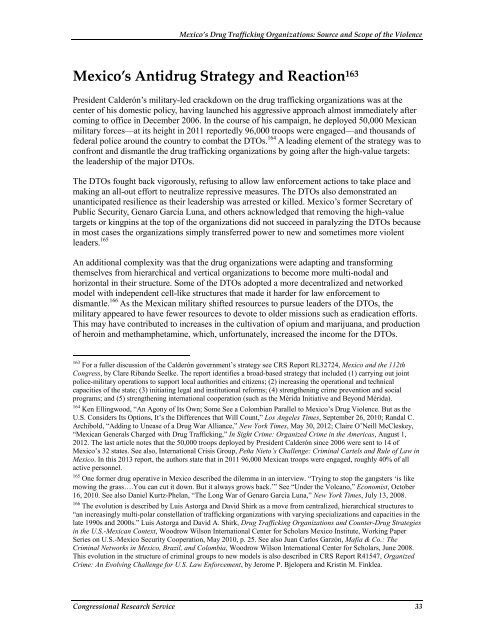Mexico's Drug Trafficking Organizations - Federation of American ...
Mexico's Drug Trafficking Organizations - Federation of American ...
Mexico's Drug Trafficking Organizations - Federation of American ...
You also want an ePaper? Increase the reach of your titles
YUMPU automatically turns print PDFs into web optimized ePapers that Google loves.
Mexico’s <strong>Drug</strong> <strong>Trafficking</strong> <strong>Organizations</strong>: Source and Scope <strong>of</strong> the Violence<br />
Mexico’s Antidrug Strategy and Reaction 163<br />
President Calderón’s military-led crackdown on the drug trafficking organizations was at the<br />
center <strong>of</strong> his domestic policy, having launched his aggressive approach almost immediately after<br />
coming to <strong>of</strong>fice in December 2006. In the course <strong>of</strong> his campaign, he deployed 50,000 Mexican<br />
military forces—at its height in 2011 reportedly 96,000 troops were engaged—and thousands <strong>of</strong><br />
federal police around the country to combat the DTOs. 164 A leading element <strong>of</strong> the strategy was to<br />
confront and dismantle the drug trafficking organizations by going after the high-value targets:<br />
the leadership <strong>of</strong> the major DTOs.<br />
The DTOs fought back vigorously, refusing to allow law enforcement actions to take place and<br />
making an all-out effort to neutralize repressive measures. The DTOs also demonstrated an<br />
unanticipated resilience as their leadership was arrested or killed. Mexico’s former Secretary <strong>of</strong><br />
Public Security, Genaro Garcia Luna, and others acknowledged that removing the high-value<br />
targets or kingpins at the top <strong>of</strong> the organizations did not succeed in paralyzing the DTOs because<br />
in most cases the organizations simply transferred power to new and sometimes more violent<br />
leaders. 165<br />
An additional complexity was that the drug organizations were adapting and transforming<br />
themselves from hierarchical and vertical organizations to become more multi-nodal and<br />
horizontal in their structure. Some <strong>of</strong> the DTOs adopted a more decentralized and networked<br />
model with independent cell-like structures that made it harder for law enforcement to<br />
dismantle. 166 As the Mexican military shifted resources to pursue leaders <strong>of</strong> the DTOs, the<br />
military appeared to have fewer resources to devote to older missions such as eradication efforts.<br />
This may have contributed to increases in the cultivation <strong>of</strong> opium and marijuana, and production<br />
<strong>of</strong> heroin and methamphetamine, which, unfortunately, increased the income for the DTOs.<br />
163 For a fuller discussion <strong>of</strong> the Calderón government’s strategy see CRS Report RL32724, Mexico and the 112th<br />
Congress, by Clare Ribando Seelke. The report identifies a broad-based strategy that included (1) carrying out joint<br />
police-military operations to support local authorities and citizens; (2) increasing the operational and technical<br />
capacities <strong>of</strong> the state; (3) initiating legal and institutional reforms; (4) strengthening crime prevention and social<br />
programs; and (5) strengthening international cooperation (such as the Mérida Initiative and Beyond Mérida).<br />
164 Ken Ellingwood, “An Agony <strong>of</strong> Its Own; Some See a Colombian Parallel to Mexico’s <strong>Drug</strong> Violence. But as the<br />
U.S. Considers Its Options, It’s the Differences that Will Count,” Los Angeles Times, September 26, 2010; Randal C.<br />
Archibold, “Adding to Unease <strong>of</strong> a <strong>Drug</strong> War Alliance,” New York Times, May 30, 2012; Claire O’Neill McCleskey,<br />
“Mexican Generals Charged with <strong>Drug</strong> <strong>Trafficking</strong>,” In Sight Crime: Organized Crime in the Americas, August 1,<br />
2012. The last article notes that the 50,000 troops deployed by President Calderón since 2006 were sent to 14 <strong>of</strong><br />
Mexico’s 32 states. See also, International Crisis Group, Peña Nieto’s Challenge: Criminal Cartels and Rule <strong>of</strong> Law in<br />
Mexico. In this 2013 report, the authors state that in 2011 96,000 Mexican troops were engaged, roughly 40% <strong>of</strong> all<br />
active personnel.<br />
165 One former drug operative in Mexico described the dilemma in an interview. “Trying to stop the gangsters ‘is like<br />
mowing the grass….You can cut it down. But it always grows back.’” See “Under the Volcano,” Economist, October<br />
16, 2010. See also Daniel Kurtz-Phelan, “The Long War <strong>of</strong> Genaro Garcia Luna,” New York Times, July 13, 2008.<br />
166 The evolution is described by Luis Astorga and David Shirk as a move from centralized, hierarchical structures to<br />
“an increasingly multi-polar constellation <strong>of</strong> trafficking organizations with varying specializations and capacities in the<br />
late 1990s and 2000s.” Luis Astorga and David A. Shirk, <strong>Drug</strong> <strong>Trafficking</strong> <strong>Organizations</strong> and Counter-<strong>Drug</strong> Strategies<br />
in the U.S.-Mexican Context, Woodrow Wilson International Center for Scholars Mexico Institute, Working Paper<br />
Series on U.S.-Mexico Security Cooperation, May 2010, p. 25. See also Juan Carlos Garzón, Mafia & Co.: The<br />
Criminal Networks in Mexico, Brazil, and Colombia, Woodrow Wilson International Center for Scholars, June 2008.<br />
This evolution in the structure <strong>of</strong> criminal groups to new models is also described in CRS Report R41547, Organized<br />
Crime: An Evolving Challenge for U.S. Law Enforcement, by Jerome P. Bjelopera and Kristin M. Finklea.<br />
Congressional Research Service 33















